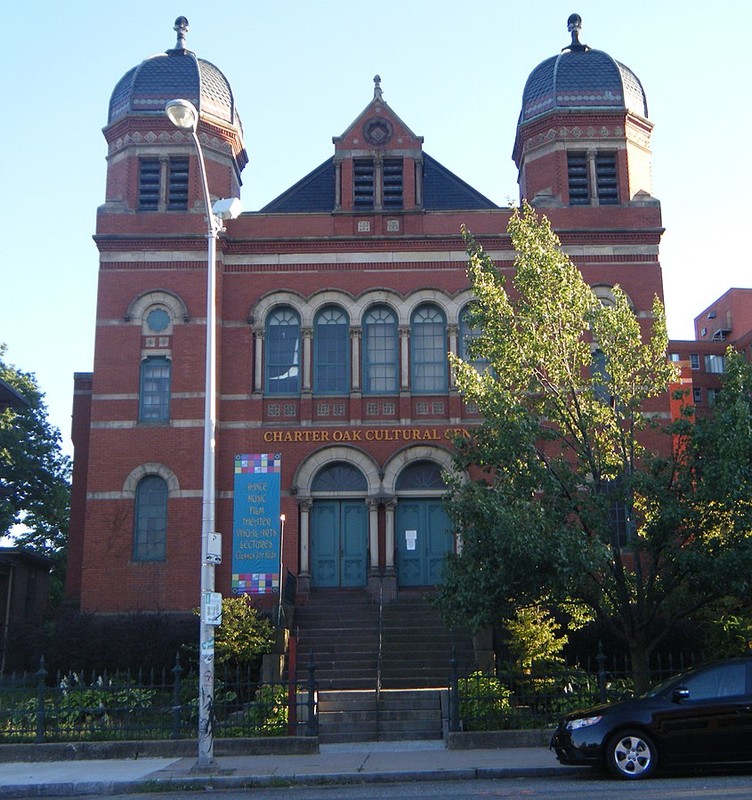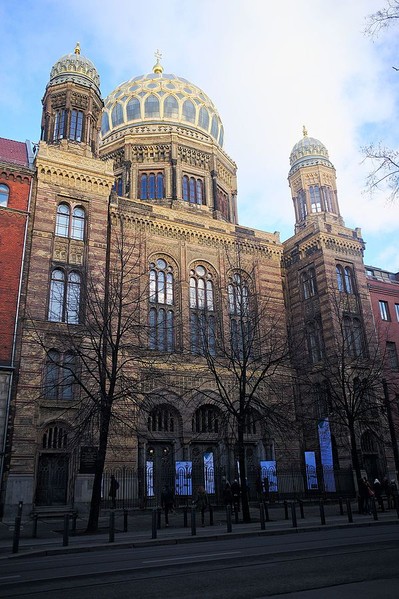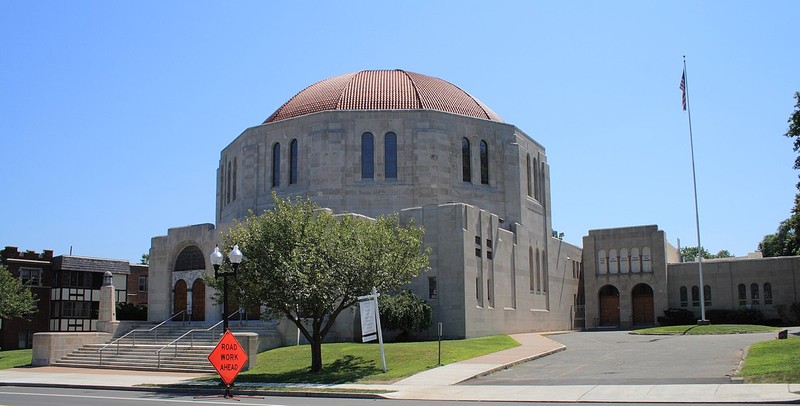Charter Oak Cultural Center
Introduction
Text-to-speech Audio
The Charter Oak Cultural Center in Hartford began as a synagogue for Congregation Beth Israel (CBI), one of Connecticut's earliest Jewish communities, which had previously conducted services in homes, workplaces, and a converted church. Built in 1876, the Charter Oak temple drew design inspiration from Berlin's New Synagogue on Oranienburgerstrasse (built 1859-66). It is the oldest synagogue building in Connecticut. During the 1930s, CBI moved to the suburbs of West Hartford and built a new synagogue there, Temple Beth Israel. No longer in use as a synagogue, the Charter Oak building has now become a cultural center.
Images
Congregation Beth Israel's synagogue on Charter Oak Avenue, now home to a cultural center.

Neue Synagoge (New Synagogue) in Berlin had an influence on the Charter Oak temple's design.

Temple Beth Israel, built 1933-1936 in West Hartford: the successor to Charter Oak Temple.

Backstory and Context
Text-to-speech Audio
Congregation Beth Israel (CBI)
The congregation was able to form in the aftermath of an 1843 decision to expand religious freedom in Connecticut. Prior to this year, Jews were forbidden from conducting public services or constructing synagogues. Connecticut's Jewish population was small, but by the mid-19th century, it was active enough to petition the Connecticut General Assembly for greater religious rights. The Assembly agreed to allow Jews freedom of worship, paving the way for the establishment of Jewish congregations and synagogues in Connecticut.
CBI's founding members were primarily German Jews who had immigrated to the United States during the 19th century. As of 1877, around the time of the Charter Oak temple's construction, Connecticut's Jewish population is estimated at 1500 (Ransom, p. 8). This number would rise dramatically in the following decades, large numbers of Eastern European Jews also immigrated to the US.
The 1870s also saw considerable changes within the traditionally Orthodox congregation. Many members wished to adopt Reform practices (e.g. installation of a choir, acquisition of an organ, changes in worship and prayer books). Ultimately, CBI members in favor of Reform won out over those preferring Orthodox Judaism. In 1874, the community appointed Dr. Solomon Deutsch, a committed reformer, as its rabbi.
Two years later, the Charter Oak Synagogue opened its doors. This architecturally striking building was designed by George Keller in the Romanesque Revival style. Like Temple Emanu-El in New York City, Charter Oak Temple took inspiration from Berlin's New Synagogue on Oranienburgerstrasse. As the first purpose-built synagogue in Connecticut, Charter Oak temple would then go on to inspire the design and aesthetic of future Connecticut synagogues.
The congregation was able to form in the aftermath of an 1843 decision to expand religious freedom in Connecticut. Prior to this year, Jews were forbidden from conducting public services or constructing synagogues. Connecticut's Jewish population was small, but by the mid-19th century, it was active enough to petition the Connecticut General Assembly for greater religious rights. The Assembly agreed to allow Jews freedom of worship, paving the way for the establishment of Jewish congregations and synagogues in Connecticut.
CBI's founding members were primarily German Jews who had immigrated to the United States during the 19th century. As of 1877, around the time of the Charter Oak temple's construction, Connecticut's Jewish population is estimated at 1500 (Ransom, p. 8). This number would rise dramatically in the following decades, large numbers of Eastern European Jews also immigrated to the US.
The 1870s also saw considerable changes within the traditionally Orthodox congregation. Many members wished to adopt Reform practices (e.g. installation of a choir, acquisition of an organ, changes in worship and prayer books). Ultimately, CBI members in favor of Reform won out over those preferring Orthodox Judaism. In 1874, the community appointed Dr. Solomon Deutsch, a committed reformer, as its rabbi.
Two years later, the Charter Oak Synagogue opened its doors. This architecturally striking building was designed by George Keller in the Romanesque Revival style. Like Temple Emanu-El in New York City, Charter Oak Temple took inspiration from Berlin's New Synagogue on Oranienburgerstrasse. As the first purpose-built synagogue in Connecticut, Charter Oak temple would then go on to inspire the design and aesthetic of future Connecticut synagogues.
Sources
Image credit 1: https://commons.wikimedia.org/wiki/File:Temple_Beth_Israel_in_West_Hartford,_August_21,_2008.jpg
Image credit 2: https://commons.wikimedia.org/wiki/File:Neue_Synagoge_(31988648135).jpg
Image credit 3: 1: https://commons.wikimedia.org/wiki/File:Temple_Beth_Israel_in_West_Hartford,_August_21,_2008.jpg
"Heritage and History." Congregation Beth Israel. Accessed December 05, 2018. https://cbict.org/heritage-and-history/.
"Historic Synagogues of Hartford." Jewish Historical Society of Greater Hartford. Accessed January 08, 2019. https://jhsgh.org/historic-synagogues-of-hartford/.
Ransom, David. "Historic Synagogues of Connecticut.' National Register of Historic Places, Multiple Property Documentation Form, U.S. Dept. of the Interior, NPS. 1995. Accessed November 10, 2018. https://npgallery.nps.gov/NRHP/GetAsset/NRHP/64500078_text.
Zande, Jane, et al. "Shaping Who We Are. Congregation Beth Israel." Accessed December 14, 2018. https://www.recollection.org/collections/view/13205.
Image credit 2: https://commons.wikimedia.org/wiki/File:Neue_Synagoge_(31988648135).jpg
Image credit 3: 1: https://commons.wikimedia.org/wiki/File:Temple_Beth_Israel_in_West_Hartford,_August_21,_2008.jpg
"Heritage and History." Congregation Beth Israel. Accessed December 05, 2018. https://cbict.org/heritage-and-history/.
"Historic Synagogues of Hartford." Jewish Historical Society of Greater Hartford. Accessed January 08, 2019. https://jhsgh.org/historic-synagogues-of-hartford/.
Ransom, David. "Historic Synagogues of Connecticut.' National Register of Historic Places, Multiple Property Documentation Form, U.S. Dept. of the Interior, NPS. 1995. Accessed November 10, 2018. https://npgallery.nps.gov/NRHP/GetAsset/NRHP/64500078_text.
Zande, Jane, et al. "Shaping Who We Are. Congregation Beth Israel." Accessed December 14, 2018. https://www.recollection.org/collections/view/13205.
